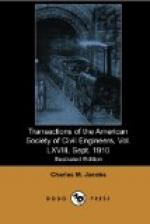It is to be remarked that while these new arrangements greatly reduce the passenger and freight water transportation, they have no effect on the large vehicular traffic across the North River which must continue to be conducted by ferries until it can be otherwise provided for. As long as these conditions exist, ferry-boats must be used in large numbers and continue to obstruct the North River. This difficulty probably cannot be overcome by the construction of bridges, as in the case of the East River, but it does not seem too much to expect that, eventually, tunnels to provide for the vehicular traffic, like the Blackwall tunnel under the Thames, will be established under the North River.
It would be interesting to estimate the increase in railroad traffic capacity resulting from these improvements, but the data required for this purpose are not available. Some idea of the increase in passenger traffic capacity resulting from the establishment of the tunnel line may be obtained by comparing the proposed daily train-movements for the new station with the train-movements at other important railroad stations. The daily train-movements of six such stations are given in the following table:
Total
trains Movement
in and out
at
for 24 hours.
maximum hour.
Jersey City 281
29
Broad Street Station, Philadelphia 538
48
Union Station, St. Louis 462
89
South Terminal Station, Boston 861
87
Grand Central Station, New York 357
44
Pennsylvania Station, New York[B] 500
50
FOOTNOTES:
[Footnote B: Proposed
train service when Station is opened, the
ultimate capacity of the Station
being in excess of 1,000 trains per
day.]
The freight capacity of the Pennsylvania System at New York has been greatly enlarged by the construction of the Greenville Yard and the facilities connected therewith, but it is impossible to estimate the amount of this increase. However, it is worthy of remark that, during the period from 1900 to 1906, the freight traffic density on the directly-operated lines of the Pennsylvania Railroad Company increased from 3,268,330 to 4,742,081 ton-miles per mile of road, a growth of nearly 50 per cent. Doubtless the improved freight facilities of the New York District had a large influence in the development of this increase.
One of the most interesting points connected with this development of traffic facilities is its influence on the relative distribution of population in the different parts of the metropolitan district. In 1907 the population per acre of the different divisions of Greater New York was reported as follows: Manhattan, 157; Brooklyn, 29; Bronx, 14; Queens, 3; Richmond, 2. The effect of new lines connecting




